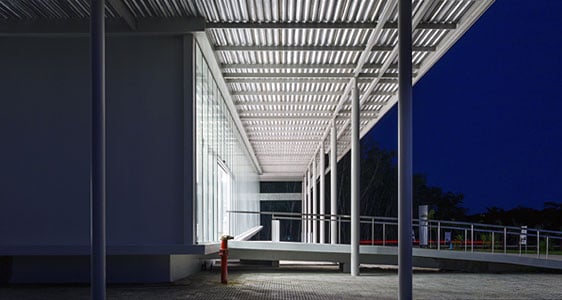
A general rule of thumb in photography and film production is that the more light, the better the image (as long as the subject isn’t overexposed). The difference between the professional photography industry and CCTV, however, is that photo and film studios typically have immaculate control of their lighting; when designing a video surveillance solution, security integrators have to work with what’s available, making circumstances even more complicated. Luckily, there are a few technological tricks that modern surveillance cameras take advantage of in order to bend the rules of lighting physics, figuratively speaking.
Before exploring some of the features that allow cameras to boost an image’s quality in sub-par lighting, it is important to understand the how truly complex capturing light can be. Illuminating a scene increases in difficulty the busier a scene is. For instance, two individuals wearing all black will absorb more light than a scene with two people dressed all in white, creating variances in the amount of light captured by the camera. If there is snow in the background, and some glossy objects in the foreground, will result in even more reflected light into a camera. Outdoor scenes with shifts in sunlight and varying positions of shadows also affect how a camera interprets the scene. Suffice to say, it’s not surprising that nearly all cameras that exist provide flexible workarounds to compensate for minute illumination changes. Depending on the quality and manufacturer of the camera and its lens, there are multiple methods of maintaining control of an image’s quality:
- Decreased aperture: For surveillance scenes with low light levels, decreasing the f-stop allows more light to pass through the lens to be captured by the image sensor.
- Increased exposure: By increasing the exposure time of the image by slowing down the shutter speed also allows more light to reach the sensor, however this is not recommended if there is any motion within the scene as the resulting image will be blurry.
- Increased gain: Higher gain levels boost the video signal, making the image brighter in dark scenarios; the drawback is an increase in noise, or graininess.
- Infrared: During the day, a camera may have sufficient illumination of either an indoor or outdoor location, but at night when no illumination source is available, infrared (IR) illuminators embedded within the camera can send wavelengths of light invisible to the naked eye to be reflected off objects within the scene. While this method is useful for covert surveillance, the resulting image is limited to black and white.
- Integrated technologies: Meticulously paired components like image sensors, lenses, and elaborate image processing, filtering, and sharpening software capabilities can produce images with better resolution and true-to-life colors in low-light situations, such as Axis Communications' Lightfinder technology.
Some of the above features are automatic on most surveillance cameras, but that shouldn’t overshadow the fact that a video surveillance system comprised of the most advanced and high quality cameras is useless if they’re lacking adequate illumination given the specific environment. When installing or upgrading a video solution with particularly complex lighting challenges, it’s equally as important to perform tests to ensure the scene will be crisp, clear, and viewable as it is to deploy the right equipment for the task.
